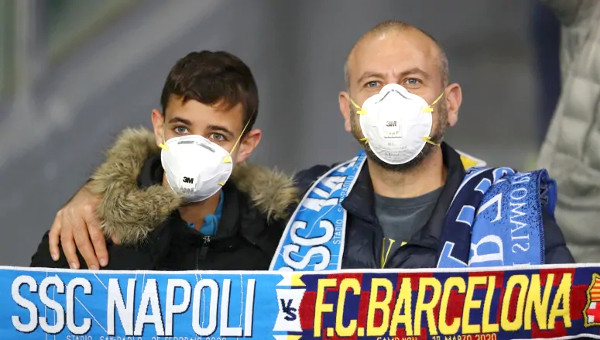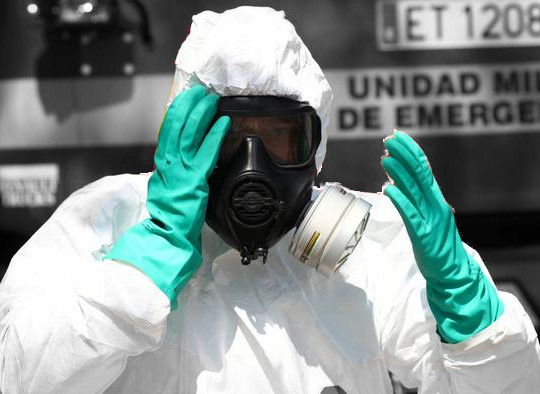The Official Story of the Coronavirus Hides a Systemic Crisis
A View from Spain
The new coronavirus (SARS-Cov-2) has many faces. The health-related facet has been thoroughly examined for weeks or, better said, scrutinized by the media, especially in countries like Spain and Italy, among others. From the last week of January to the time of writing this text (March 9), the coronavirus is known to have infected more than 114,000 people in more than 100 countries, with over 4,000 individual deaths caused by COVID-19. And it is more than likely that several thousand more deaths will be added to the count in the coming weeks or months, in what is already a pandemic.

Without a doubt, it is a serious health problem, but not the most important one, and perhaps not even the most urgent. An example of this is the case fatality rate, estimated at 3.4 per cent, which can be compared with 11 per cent for SARS (Severe Acute Respiratory Syndrome) or 34 per cent for MERS (Middle East Respiratory Syndrome). However, let us think that on average more than 1,100 people die every day in Spain from very different causes, and that the common flu causes between 6,000 and 15,000 deaths annually in Spain. We do not know how many people are infected with the coronavirus, but it seems very likely that a high percentage of cases will go unnoticed, with undetected or unrecorded symptoms, which would imply that the actual case fatality rate would be considerably lower than that registered so far.
Worrying Health Issue
However, this does not mean that the coronavirus is not a relevant or even worrying health issue. Firstly, because the mortality generated by COVID-19 in the most advanced age groups or in people with previous pathology is high (about 15 per cent in those over 80 years of age) and its morbidity and general health impairment may be important. Secondly, coronavirus is highly contagious, leading to a prominent public health problem in many countries and potentially for all. China, Italy, Iran, South Korea, France, Spain, and US are the most affected so far. Although the risk of mortality is low, given that the potential number of people affected could be very high, this could lead to a very high total death count.
Thirdly, because the impact of the epidemic on the health system can be significant for various reasons: the incubation period in which people are contagious is five days; the number of cases is exponential; a high percentage will require hospitalization either due to their clinical situation or the need for surveillance or isolation; patients should be isolated until they are no longer contagious, which requires fine screening systems, a high volume of sample processing at referral centers, and integrated governance of clinical and public health decisions to identify patients screened and placed in quarantine and to decide whether it should be done at home or in a hospital center.
Furthermore, an important part of the work of many Spanish health professionals is being dedicated to addressing the ongoing emergency. To this is added that health personnel are the most exposed group and at the same time the group with the highest risk of infecting particularly vulnerable individuals against the infection, meaning that the overload at the personnel level is twofold. Scientific societies of different medical specialties have produced joint protocols and very valuable information documents. However, the complexity and cost associated with these exceptional measures are high and pose a lot of stress for the healthcare system, which translates into a considerable risk of overflow or even collapse if hospitals act for a long period of time as the main way to contain the epidemic. And finally, another reason for concern is that it is likely, at least in the short term, that it is a “recurring” epidemic: it may recur every year. It seems likely that SARS-CoV-2 is here to stay, and that it will remain among the viruses that routinely affect humanity, as did influenza A.
Globalization, Humans, and Viruses
Another issue is that epidemics of an origin similar to the current coronavirus may appear, and may be even more serious, which could generate a pandemic with much higher global mortality. It should not be forgotten that the cause of the current outbreak (and other previous ones such as SARS-CoV in 2002, avian influenza (H5N1) in 2003, swine flu (H1N1) in 2009, MERS-CoV in 2012, Ebola in 2013 or the Zyka (ZIKV) in 2015), lies to a large extent, in the complex transmission through animals to humans in relation to the development of intensive agriculture and poultry farming and the growing market for and consumption of wild and exotic animals. Added to this is the ability of epidemics to spread due to factors such as the lack of hygiene and adequate resources invested in public health, urban density, and tourism globalization, among other factors.1 Globalization has transformed the relationship between humans and viruses where the local is global and the global is local. Moreover, many countries do not have effective public health systems which can face the challenges that arise, nor is there an appropriate global public health system.
In any case, most countries that have effective public health resources, in which drastic measures have been applied such as those taken in China, where a city of 11 million inhabitants like Wuhan in the Hubei region (58 million) has been in a draconian quarantine since the end of January, only now seems to be receding, or in Japan that has closed schools for weeks, or in Italy or Spain that are progressively expanding the territory of control and containment of the coronavirus should be able to contain the epidemic in a relatively brief time period, thus preventing the impact on collective health from worsening over time. A very different situation could occur in many poor countries with very weak health systems and very poor social determinants of health (i.e., poverty, urban overcrowding, faulty or non-existent waste water systems, negligence of the pharmaceutical industry, weak public health systems, poor diets, etc.). This is the case in many African countries, where the risk of the epidemic causing very notable or even extreme damage is high.
A Systemic and Political Problem
But if the public health problem is not necessarily as extremely alarming as is typically presented in the media, why then has this epidemic been treated as a problem that deserves almost exclusive attention and with real-time monitoring? The reason is that COVID-19 is not only a global health problem, but is also a problem with interconnected facets of an economic, ecological and social nature, making it a systemic and political problem on which it is necessary to reflect. From an economic point of view, according to numerous analysts, consultants or auditors such as Deloitte, the IMF, or the OECD itself,2 the epidemic has contributed to slowing down the economy and generating less growth, with a decrease in production, trade, consumption, tourism, and transportation, or even stock market falls. Factories and businesses are closing, millions of people are not making their usual trips; teleworking, video conferencing and the increase of local production to protect supply chains are all being encouraged; and there has been a sharp rise in the prices of products such as gels, disinfectants, and masks. In an economy as interdependent, chaotic and fragile as capitalism, in which uncertainty, speculation and the constant search for profit are essential characteristics, the complex future systemic consequences are unknown. Nevertheless, everything pointed to the possibility of a close and serious economic recession well before the appearance of the coronavirus.
From an ecological point of view, closely connected to the economical, the economic slowdown has reduced the consumption of fossil fuels, along with the emission of CO2 and air pollution. For example, in China oil consumption and gas emissions have already been reduced significantly by 25 per cent and the same will happen in many other countries. The effects of the coronavirus epidemic may seem paradoxical: its obvious negative effects on health, society and the economy in the short term are beneficial for the climate and ecological crisis, and perhaps also beneficial for health in the medium term (such as in any economic crisis, by slowing down industrial activity and transport, mortality and morbidity associated with accidents at work, traffic, environmental pollution, etc. are reduced). This apparent paradox is cleared when it is understood that the logic of exponential growth and many of the characteristic developments of capitalism are highly detrimental to the homeostasis of the planet and social development, and therefore to collective health.
From the social point of view, we are facing a panic epidemic, the origin of which we can trace in some of its essential characteristics: the Coronavirus epidemic is not a highly lethal epidemic but it is new and of an origin not yet fully clarified; we cannot predict its evolution, which creates great uncertainty; there is no effective treatment or vaccine; it has spread rapidly in the richest countries on the planet and in all kinds of social classes; the mass media and new social networks have magnified the impact of the process on a population that is mostly risk phobic; the epidemic is an opportunity to degrade and isolate China, while locally creating racist and xenophobic responses.
But the COVID-19 crisis also raises two additional important issues. On the one hand, it highlights the essential role of governments, services and public research to control the epidemic in a coordinated way, but it can also give rise to a probable “authoritarian epidemic,” visible in China, with extreme surveillance and control measures used to detect unknown cases of infection and the application of restrictive measures that are at best not very transparent, and at worst directly repressive.3

The lack of clarity in the information disseminated is also reflected in some media “crazy about the immediacy,” which are tied to the power of large corporations, and who basically seek an audience through immediate emotional impact and entertainment, and who are unable to transmit a critical and systemic diagnosis of what happens. Second, the current coronavirus “media epidemic” represents an “opportunity cost” in a sense well known to many politicians: when you don’t want to talk about one annoying topic, you distract yourself by talking about another.4 Examples are Bill Clinton’s attacks in Sudan and Afghanistan to cover up his affair with Monica Lewinsky, or the release of politicians with corruption charges by Silvio Berlusconi the same day that Italy qualified for the final of the World Cup in football. And the fact is that when talking almost exclusively about the coronavirus for so many weeks we do not talk about other much more serious problems that go unnoticed. As the Spanish philosopher Santiago Alba Rico has recently pointed out: “Since Covid-19 exists, nothing happens anymore. There are no more heart attacks or dengue or cancer or other flu or bombings or refugees or terrorism or anything. There is no longer, of course, climate change.”5 Or also the Spanish economist Fernando Luengo when saying that there is no longer talk of the “high indebtedness of private non-financial corporations, the umbilical cord that unites the policy of central banks to large banks and corporations,” or “the increase in the inequality, wage repression,” nor the drama of “the refugees in Lesbos, crushed by the Greek police and the extreme right,” or the “murders of women.”6 Nor, of course, is there any mention of the atrocious ecological crisis that we are living, which endangers life on the planet and the very existence of humanity, or the massive job precariousness suffered by billions of people in the world, including the Italian researchers at the University of Milan and the Sacco Hospital who isolated the coronavirus strain.
COVID-19 is a complex detonator of the systemic crisis of capitalism, where all the above factors are strongly interconnected, and cannot be separated from each other. Everything seems to indicate that this epidemic may represent an ideal occasion to justify the capitalist economic crisis that seems to be approaching.7 Fear produces a sharp drop in demand, which lowers the price of oil, which reverts to the emergency of a crisis foretold. And it is very likely that the coronavirus is not “the only one responsible” for the drop in the stock markets as is said, nor for a slowed capitalist economy with stagnant corporate profits and industrial investment, but rather is the spark of a postponed economic crisis where the poor health of the economy predates the epidemic. As several critical economists such as Alejandro Nadal, Eric Toussaint or Michael Roberts have pointed out,8 although the stock markets are unpredictable, all the factors of a new financial crisis have been around since at least 2017. The coronavirus would be the spark that caused a financial explosion, but not its main cause.9

Furthermore, the role of the giant shareholders (investment funds such as BlackRock and Vanguard, large banks, industrial companies, and billionaires) in the stock market destabilization experienced in recent weeks should not be underestimated in advance. These agents would thus reap the benefits of recent years and avoid losses, investing in the safest but least profitable public debt securities, and demanding that governments once again use public resources to mitigate economic losses.
The propaganda of the big economic and media groups hides the reality and prevents an adequate understanding of what is happening. Transforming the complex social structure of a train without brakes such as capitalism requires imagining a different society and making a radical change with systemic global policies in ecology, economy and health. It requires imagining, designing and experimenting with alternative models of life in a productive model, alongside fairer, more homeostatic, simpler and healthier lives. A necessary first step is not to deceive ourselves with the mainstream media’s incomplete, emotional or toxic information about the coronavirus, and to try to understand the systemic crisis it hides. •
Originally published in Spanish at ctxt (March 10th, 2020).
Endnotes
- It occurs through a chain reaction, with a positive disaster feedback, common in poor countries. Mike Davis. The Monster at Our Door, New York, The New Press, 2005.
- The OECD warns of the possibility that Covid-19 halves global economic growth in 2020, which could go from 2.9 per cent to 1.5 of GDP. Michael Roberts. “Disease, Debt, and Depression.”
- Covid-19: too Little, too late? Lancet 2020;395:P755 (7 March 2020).
- See for example: Christenson DP Kriner DL. Mobilizing the public against the president: Congress and the political costs of unilateral action. American Journal of Political Science 2017;61(4):769-785; Djourelova, M and R Durante (2019), “Media Attention and Strategic Timing in Politics: Evidence from US Presidential Executive Orders,” CEPR Discussion Paper 13961; Durante R, Zhuravskaya E. Attack when the world is not watching? US media and the Israeli-Palestinian conflict. Journal of Political Economy 2018;126(3):1085-1133.
- Santiago Alba Rico. “Apología del contagio.” Ctxt, 09-03-2020.
- Fernando Luengo. “La cortina de humo del coronavirus.” Público, 09-03-2020.
- Since this recession is not caused by a lack of demand but of supply (loss of production, investment and trade), Keynesian and monetarist solutions will not work. The main cause of stagnation is the decrease in the return on capital. Huge debt, particularly in the corporate sector, is a recipe for a serious collapse if the return on capital drastically declined. The epidemic ends up weakening a financial system that has the potential to trigger a new debt crisis that could lead to the collapse of companies and the financial world. Michael Roberts. “Disease, Debt, and Depression.”
- Eric Toussaint. “No, the Coronavirus is Not Responsible for the Fall of Stock Prices.” The Bullet. Alejandro Nadal. “Tasa de interés: ¿vacuna contra el coronavirus?” Sin Permiso, 04-03-2020. Michael Roberts. “G20 and COVID-19.” 23-02-20, and “Disease, Debt, and Depression.” 05-03-20.
- Before the appearance of the new coronavirus, disturbing indicators of the world economy had already manifested themselves, such as the reversal of the yield curve (the returns on shorter-term securities outweigh those on long-term securities), which is an indication of how bad which are the expectations of investors. An example of this type of distortion is the different conventional evaluations of the last quarters in the stock market, which reveals how this market has become cheaper in relation to the performance of 30-year bonds. And that is not a new phenomenon: the inversion of the yield curve in European markets has been taking place for years and in recent years it has been approaching record levels. Alejandro Nadal. “Tasa de interés: ¿vacuna contra el coronavirus?” Sin permiso. 04-04-2020.





